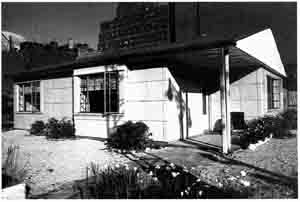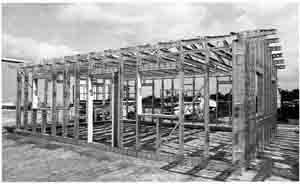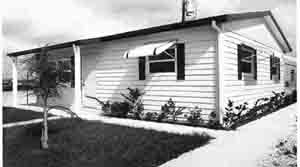
One of Carl Strandlund’s Lustron houses, built in the
late 1940s. Studs, joists, trusses, walls in side and out, and even the
roofing tiles were made of steel.
One of the most low-maintenance homes ever built was the Lustron in the late 1940s, the brainchild of Carl Strandlund. Strandlund had the idea of manufacturing houses in factories, shipping them to the building site and erecting them, ready to move into, in less than three weeks. (Another of those “new” ideas that isn’t really new at all.) The Lustron was noteworthy because it had hardly a speck of wood in it. Studs, joists, roof trusses—everything—was steel. Exterior and interior wall panels were porcelainized steel, which gave the Lustron its distinctive look in sprightly pastel colors. Even the roof shingles were porcelainized steel. The house, which came in several models, was impervious to the weather. Maintenance, inside and out, amounted to wiping with a wet rag. Some people simonized their Lustrons! Porcelain will chip, of course, but it can be touched up with enamel. More major repairs can be handled admirably with auto-body putty, and if the houses would have caught on, auto repairmen would have discovered another way to make a living.
But, alas, they didn’t. The government pumped millions of dollars into the project and hence it became a political football, not without the usual suspicions and allegations of scandal. But mostly, Strandlund was way ahead of his time. People of a Wood Culture were not accustomed to thinking of life in a steel house, and though lovers of Art Deco found Lustrons most interesting, if not downright attractive, the ordinary homebuyer thought they looked like colorful diners, or White Castle hamburger joints in technicolor. Only something less than 5,000 Lustrons were built, but many of them still stand, virtually indestructible. Retrofitted with more insulation in these days of higher fuel costs, the Lustron makes a wonderful starter home, say people who still live in them. The only item in the original houses that didn’t perform well was the combination clothes washer/dishwasher!
I hope though, that Strandlund’s main contribution to home- building—a cheaper process of porcelainizing steel—will not be ignored. Enameling, as this process is called when artists do it on copper, is an ancient craft, with a potential for limitless colors and patterns, some of breathtaking beauty. Finding a way to reduce costs enough so the process could be used in commercial manufacturing led to the avocado-colored refrigerator, whose passing no one laments. But with a little imagination, the process could be used for interior walls, and yes, exterior ones too, impervious to wear and moisture and extremely attractive.
Steel Houses of Today
Steel homes are very much back in the news now, and this time the public is more favorably disposed. Not too surprisingly, the attraction to all steel homes is in the South, where mildew, rot, and termites exact such a price from wood, and where wood’s superior insulative properties are not as necessary.

The Madray house, a modern version of the steel
frame house, displaying here its steel skeleton.

The finished Madray house looks very much like
a conventional pre fabricated house.
Madray Building Systems (P.O. Box 712, Okechobee, FL 33473) has been in production only two months at this writing, and , says Trudy Kogut, who not only works for Madray but is also building one of the houses, “we’ve just been overwhelmed with inquiries and orders from all over the world.”
Madray makes and sells structural steel components for the frame of the house. Choice of exterior and interior finish is left to the homeowner, but if you want metal siding (and roofing), the firm sells Galvalume (from Bethlehem Steel) in several colors. Galvalume is steel that's plated with an aluminum/zinc alloy. The finish is guaranteed for 20 years. “The finish ‘bleeds’ if chipped by a rock,” says Kogut, “which means that it runs back together to cover the blemish.” Galvalume also has good durability in the salty air of oceanside locations, where ordinary galvanized metal will deteriorate rather rapidly.
The framework of a steel home will remind you of the toy erector sets children used to play with, only full size. Because of the way the pieces go together, at least with Madray and I presume the others (see below and in Appendix A), proper squareness and straightness is automatic. You don’t have to fiddle around with a level all the time.
A Madray house frame can be erected in less than an hour, using unskilled labor, as the company demonstrates before TV cameras. Cost is very competitive with wood homes. “Frankly, as a single mother with three children, it's the only new home I’ve found that I can afford,” says Kogut. The company is not yet publishing final cost figures, but it appears the house will cost less than $25 a square foot, not counting heating and air-conditioning units. “Another advantage is that you can stockpile the components until you have enough money to start building and they won’t wrap, swell, rot, or split,” says Kogut. “Or you can build the frame and let it stand until you can afford the rest without worrying about the weather.”
The steel frame allows for 6 inches of insulating space inside the walls. “Walls and roof have an R-19 rating,” says Kogut, “and you can add more insulation if you want.” The exteriors can be wood-paneled, stuccoed, or whatever. “Stucco is very popular here in the South,” says Kogut, “and works well with our homes to make an extremely low-maintenance, long-lasting house.”
Tn-Steel Structures, Inc. (1400 Cresent, Denton, TX 76201 ), is an other manufacturer of modem steel houses. Tn-Steel makes simulated tile out of galvanized steel for roofing and galvanized steel panels for exteriors at a cost of about $55 a square. (For more information about such steel structures, see Steel Homes, by Drs. Carl and Barbara Giles Tab Books, 19811.)